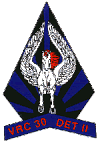
USS Ronald Reagan (CVN-76) is a Nimitz-class, nuclear-powered supercarrier in the service of the United States Navy. The ninth ship of her class, she is named in honor of Ronald W. Reagan, President of the United States from 1981 to 1989. She was built at Newport News Shipbuilding in Newport News, Virginia, and was commissioned on 12 July 2003.

The Grumman C-2 Greyhound is a twin-engine, high-wing cargo aircraft designed to carry supplies, mail, and passengers to and from aircraft carriers of the United States Navy. Its primary mission is carrier onboard delivery (COD). The aircraft provides critical logistics support to carrier strike groups. The aircraft is mainly used to transport high-priority cargo such as jet engines and special stores, mail, and passengers between carriers and shore bases.

Carrier onboard delivery (COD) is the use of aircraft to ferry personnel, mail, supplies, and high-priority cargo, such as replacement parts, from shore bases to an aircraft carrier at sea. Several types of aircraft, including helicopters, have been used by navies in the COD role. The Grumman C-2 Greyhound has been the United States Navy's primary COD aircraft since the mid-1960s.

Naval Air Facility Atsugi is a joint Japan-US naval air base located in the cities of Yamato and Ayase in Kanagawa, Japan. It is the largest United States Navy (USN) air base in the Pacific Ocean and once housed the squadrons of Carrier Air Wing Five (CVW-5), which deploys with the American aircraft carrier USS Ronald Reagan.

849 Naval Air Squadron was a squadron of the Fleet Air Arm, the Air Arm of the British Royal Navy. It was formed during the Second World War as a carrier based torpedo-bomber, unit, flying missions against Japanese targets in the Far East. Its service since the Second World War has been as an airborne early warning squadron, flying fixed winged Skyraiders and Gannets from the Royal Navy's fixed wing carriers from 1952 until 1978, and airborne early warning Sea King helicopters from 1982 to 2018.

Electronic Attack Squadron 135 (VAQ-135), known as the "Black Ravens", is a United States Navy electronic attack squadron that currently operates the EA-18G Growler carrier-based electronic warfare jet aircraft. The squadron is permanently stationed at Naval Air Station Whidbey Island with a radio callsign of "Thunder".

A naval aviator is a commissioned officer or warrant officer qualified as a crewed aircraft pilot in the United States Navy or United States Marine Corps. United States Coast Guard crewed aircraft pilots are officially designated as "Coast Guard aviators", although they complete the same undergraduate flight training as Navy and Marine Corps crewed aircraft pilots, and are awarded the same aviation breast insignia.

A carrier air wing is an operational naval aviation organization composed of several aircraft squadrons and detachments of various types of fixed-wing and rotary-wing aircraft. Organized, equipped and trained to conduct modern US Navy carrier air operations while embarked aboard aircraft carriers, the various squadrons in an air wing have different but complementary missions, and provide most of the striking power and electronic warfare capabilities of a carrier battle group (CVBG). While the CVBG term is still used by other nations, the CVBG in US parlance is now known as a carrier strike group (CSG).
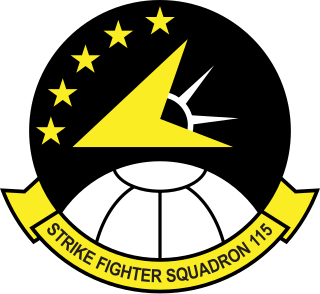
Strike Fighter Squadron 115 (VFA-115) is known as the "Eagles", callsign "Talon", a United States Navy F/A-18E Super Hornet strike fighter squadron stationed at Marine Corps Air Station Iwakuni. Their tail code is NF. It was established as Torpedo Squadron VT-11 on 10 October 1942, redesignated VA-12A on 15 November 1946, VA-115 on 15 July 1948, then finally VFA-115.

Carrier Air Wing Five (CVW-5) is a United States Navy aircraft carrier air wing based at Marine Corps Air Station Iwakuni. The air wing is attached to the aircraft carrier USS Ronald Reagan. It was initially formed in 1943. It has participated in the Second World War, the Korean War, the Gulf War, Operation Southern Watch, the War in Afghanistan, and the War in Iraq.

Carrier Air Wing Seventeen (CVW-17), is a United States Navy aircraft carrier air wing based at Naval Air Station Lemoore, California. The air wing is attached to the aircraft carrier USS Nimitz.

Fleet Logistics Support Squadron 40 (VRC-40), also known as the "Rawhides", is a United States Navy fleet logistics support squadron based at NS Norfolk. Commissioned in 1960, it is one of only two active fleet logistics squadrons in the Navy, the other being VRC-30.

Helicopter Sea Combat Squadron 14 (HSC-14) "Chargers" is an aviation unit of the United States Navy based at Naval Air Station North Island, California (USA). HSC-14 was established as Helicopter Anti-Submarine Squadron 14 (HS-14) in 1984 and was redesignated HSC-14 in 2013. The squadron is equipped with the Sikorsky MH-60S Seahawk.
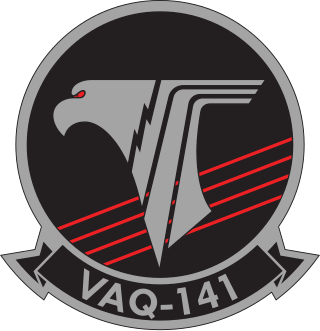
Electromagnetic Attack Squadron 141 (VAQ-141), also known as the "Shadowhawks", is an EA-18G Growler squadron of the United States Navy that is based at Marine Corps Air Station Iwakuni, located in Iwakuni, Yamaguchi, Japan. VAQ-141 falls under the cognizance of Commander, Electromagnetic Attack Wing Pacific (COMVAQWINGPAC) and flies in support of Carrier Air Wing 5 (CVW-5) aboard the Nimitz-class aircraft carrier, USS Ronald Reagan (CVN-76).

Carrier Airborne Early Warning Squadron 112 (VAW-112) is an inactive United States Navy squadron. It was nicknamed the "Golden Hawks". VAW-112 flew the E-2C Hawkeye out of NAS Point Mugu and last deployed in 2013 as part of Carrier Air Wing 9 (CVW-9) on board USS John C. Stennis.
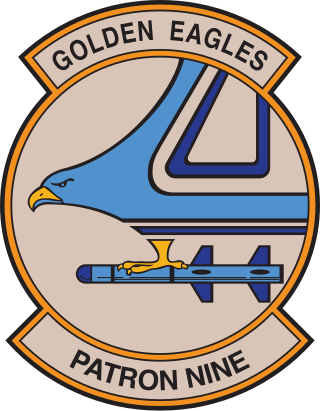
Patrol Squadron 9 (VP-9) is a U.S. Navy patrol squadron with its homeport located at Naval Air Station Whidbey Island. As of 2018, VP-9 is part of Patrol and Reconnaissance Wing Ten, Commander, Naval Air Forces, Pacific.

Airborne Command & Control Squadron 120 (VAW-120) is a United States Navy Fleet Replacement Squadron responsible for training crews on the E-2 Hawkeye and the C-2A(R) Greyhound.
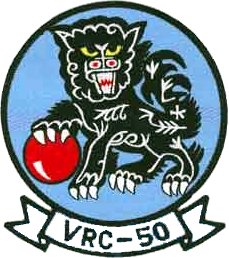
VRC-50 was a Fleet Logistics Squadron of the U.S. Navy. The squadron was established as Fleet Tactical Support Squadron 50 (VRC-50) on 1 October 1966, redesignated as Fleet Logistics Support Squadron Fifty (VRC-50) on 1 April 1976 and disestablished on 7 October 1994.






